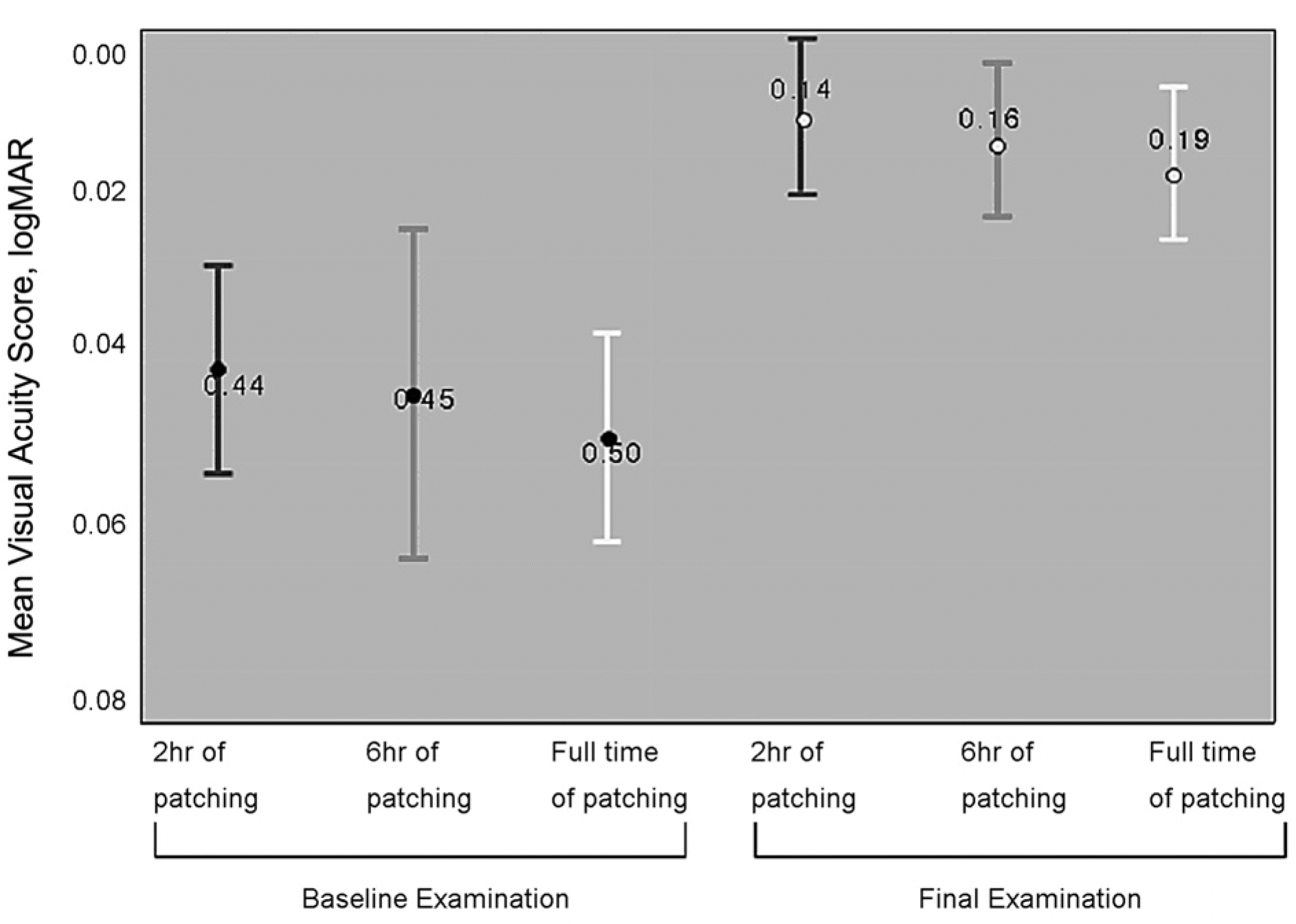Abstract
Purpose
To compare effects of a 2-hour, 6-hour, and full-time patching regimens in monocular amblyopia patients under 10 years of age.
Methods
This study recruited monocular amblyopia patients under 10 years of age. The patients were divided into a 2-hour patching group (group A, n=34), a 6-hour patching group (group B, n=33), and a full time patching group (group C, n=28) according to the patching time. A prospective analysis was then performed. The ages at the start of treatment, differences of corrected visual acuity between the 2 eyes and severity of the 3 groups were compared and analyzed. On the final evaluation, ‘success’ was defined when the difference of corrected visual acuity between the 2 eyes converted into logMAR was less than 0.1.
Results
The ages at the start of treatment in group A, B, C were 5.61, 5.48 and 5.71 years, respectively. The best corrected visual acuity of an amblyopic eye converted into logMAR changed to 0.13 after treatment in group A, to 0.16 in group B and to 0.19 in group C. Although visual acuity after the treatment was increased significantly compared to the beginning of treatment in all 3 groups, the final visual acuity showed no statistically significant difference among the 3 groups. Because the occlusion therapy success rates were 70.6%, 69.7% and 64.3% for groups A, B and C, respectively, there was no statistically significant difference.
Conclusions
In the 2-hour, 6-hour, and full-time patching regimens, all patients showed a significant improvement in visual acuity although their success rates were not significantly different. Therefore, the part-time patching therapy favored by patients and parents is effective for the first treatment of amblyopia.
Go to : 
References
1. von Noorden GK. Binocular Vision and Ocular Motility. 6th ed.St. Louis: CV Mosby;2002. p. 246.
2. Freedman HL, Preston KL. Polaroid photoscreening for amblyo-genic factors. Ophthalmology. 1992; 99:1785–95.

3. Friedmann L, Biedner B, David R, Sachs U. Screening for refractive errors, strabismus and other ocular anomalies from ages 6 months to 3 years. J Pediatr Ophthalmol Strabismus. 1980; 17:315–7.

6. Lowe RF. Atropine treatment for amblyopia ex anopsia. Br Orthopt J. 1965; 22:35–42.
7. Bangater A. Die okklusion in der pleoptik und orthoptik. Klin Monatsbl Augenheilkd. 1960; 136:305–31.
8. Banks RV, Campbell FW, Hess R, Watson PG. A new treatment for amblyopia. Br J Ophthalmol. 1978; 62:748–55.
9. Lee JH, Choi DG. Effect of levodopa on visual function in amblyopia. J Korean Ophthalmol Soc. 1996; 37:1354–59.
10. Jin YH. The strabismus, revised edition Ulsan: publishing department. Ulsan university. 2000; 220.
11. The Pediatric Eye Disease Investigator Gorup. A randomized trial of patching regimens for treatment of moderate amblyopia in children. Arch Ophthalmol. 2003; 121:603–11.
12. The Pediatric Eye Disease Investigator Group. A randomized trial of prescribed patching regimens for treatment of severe amblyopia in children. Ophthalmology. 2003; 110:2075–87.
13. Wick B, Wingard M, Cotter S, Scheiman M. Anisometropic amblyopia: is the patient ever too old to treat? Optom Vis Sci. 1992; 69:866–78.

14. Kim YH, Choi MY. The prospective comparison of the efficacy of intermittent atropine penalization and part-time occlusion therapy. J Korean Ophthalmol Soc. 2008; 49:958–66.

15. Foley-Nolan A, McCann A, O'keefe M. Atropine penalization versus occlusion as the primary treatment for amblyopia. Br J Ophthalmol. 1997; 81:54–7.
16. Mintz-Hittner HA, Fernandez KM. Successful amblyopia therapy initiated after age 7 years. Arch Ophthalmol. 2000; 118:1535–41.
17. von Noorden GK. Mechanisms of amblyopia. Adv Ophthalmol. 1977; 34:93–115.
18. von Noorden GK. Binocular vision and ocular motility, 6th ed. St. Louis: CV Mosby. 2001; 13:211–45.
19. Lee CS, Shin MK, Paik HJ. Evaluation of factors affecting the outcome of occlusion treatment for amblyopia. J Korean Ophthalmol Soc. 2001; 42:1740–6.
20. Flynn JT, Schiffman J, Feuer W, Corona A. The therapy of amblyopia: an analysis of the results of amblyopia therapy utilizing the pooled data of published studies. Trans Am Ophthalmol Soc. 1998; 96:431–50.
21. Woodruff G, Hiscox F, Thompson JR, Smith LK. Factors affecting the outcome of children treated for amblyopia. Eye. 1994; 8:627–31.

22. Beardsell R, Clarke S, Hill M. Outcome of occlusion treatment foramblyopia. J Pediatr Ophthalmol Strabismus. 1999; 36:19–24.
23. Hiscox F, Strong N, Thompson JR, et al. Occlusion for amblyopia: a comprehensive survey of outcome. Eye. 1992; 6:300–4.

24. Ching FC, Parks MM, Friendly DS. Practical management of amblyopia. J Pediatr Ophthalmol Strabismus. 1986; 23:12–6.

25. Moon CS, Jin YH. Timing of amblyopia therapy in pure anisometropic amblyopia. J Korean Ophthalmol Soc. 1998; 39:185–92.
26. Kim YT, Chang HR. Follow-up results of the monocular amblyopia. J Korean Ophthalmol Soc. 1998; 39:2803–9.
27. Oliver M, Neumann R, Chaimovitch Y, et al. Compliance and results of treatment for amblyopia in children more than 8 years old. Am J Ophthalmol. 1986; 102:340–5.

28. Oh DE, Lim KH. Efficacy of occlusion therapy in amblyopia: type, depth and timing of amblyopia. J Korean Ophthalmol Soc. 2003; 44:2850–6.
29. Romano PE, Romano JA, Puklin JE. Stereoacuity development in children with normal binocular single vision. Am J Ophthalmol. 1975; 79:966–71.

30. Flynn JT, Woodruff G, Thompson JR, et al. The therapy of amblyopia: an analysis comparing the results of amblyopia therapy utilizing two pooled data sets. Trans Am Ophthalmol Soc. 1999; 97:373–90.
31. Scott WE, Stratton VB, Fabre J. Full time occlusion therapy for amblyopia. Am Orthopt J. 1980; 30:125–30.
Go to : 
 | Figure1.Visual acuity measurements in the amblyopic eye in each group at baseline and final follow up. The point estimates and 95% confidence intervals are shown. The difference between treatment groups in mean logMAR acuity and the 95% confidence intervals were adjusted for baseline visual acuity. |
Table 1.
Comparison of baseline characteristics of 2-hour vs 6-hour-vs full-time daily patching
Table 2.
Visual acuity improvements stratified by baseline characteristics in 2-hour, 6-hour and full-time patching




 PDF
PDF ePub
ePub Citation
Citation Print
Print


 XML Download
XML Download